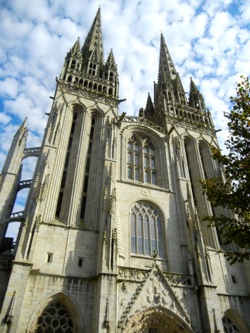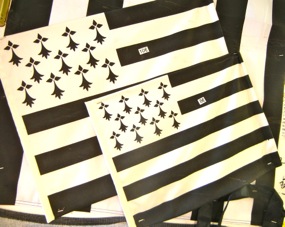 |
Quimper, Bretagne, France | |
| This charming city provides a glimpse of traditional Breton life. | ||
|
|
|
Quimper is known around the world for its distinctive faïence, or hand-painted pottery depicting typical Breton people and scenes. People in the Quimper area have been making pottery for over three centuries. It's also the capital of the Finistère (Land's End) Department and the cultural center of the historical region of Cornouaille (Cornwall). You'll find lots of names and signs in Breton, including the Tourist Office, Ti an douristed, and the town name itself, Kemper. The Odet River and a charming small canal run through the center of town; boat trips on the Odet are possible in season. The old town center has a large pedestrian area and the major sites can easily be visited on foot. The Cathédrale St-Corentin dominates the main square. There are plenty of cafés where you can enjoy a meal or a drink and people watch. Named for Saint Corentin, a fifth century Bishop of Cornouaille, this large church was built between the 13th and 19th centuries. The interior has beautiful sculpture and stained glass. Just across the square from the Cathedral is the Musée des Beaux-Arts, or Fine Arts Museum, which focuses on European painting and also the works of Max Jacob, who was born in Quimper. Another favorite son honored with a statue in the main square is René Laennec, inventor of the stethoscope! Quimper has a large museum devoted to Breton history and traditional life. The Musée Départemental Breton is also near the Cathedral. As a center of traditional Breton life, Quimper also has many crêperies. Crêpes and cider make for a tasty local meal. Several restaurants are clustered around the wonderfully named Place au Beurre, or Butter Square. The main shopping street is Rue Kéréon, right in the heart of the old town. You'll find all sorts of faïence and other souvenirs. Nearby are the Halles, or food markets, always a bustling scene. If you want to see more pottery, you'll need to head about 1.7 kilometers (one mile) southwest along the river. Here you'll find the small Musée de la Faïence (open seasonally; check with the Tourist Office). You can also visit the factory of HB Henriot, one of the most famous faîenceries (call for times and details). As a historic city, Quimper still has remains of walls and towers surrounding it. Signs in both French and Breton explain the various sections of the walls. A visit to Quimper provides a glimpse into Breton culture, language, and traditions. Somewhat out of the way and less touristic than some other parts of Brittany, Quimper is a real working city and a pleasure to visit. It's a short drive from Carnac, site of prehistoric standing stones, and the Quiberon Peninsula, as well as the medieval towns of Josselin and Vannes.
|
|
Above, Soaring towers of St-Corentin Cathedral, Quimper. |


